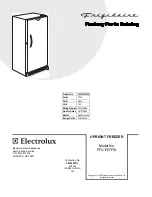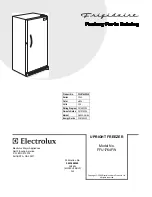
33
STORING FOOD IN YOUR FREEZER
The use of temperatures of -18°C or colder to store food means that the food can be
kept for longer periods than when refrigeration temperatures are used. This is because
the growth of bacteria, moulds and yeasts are stopped, and chemical and physical
reactions are severely restricted at such low temperatures.
Frozen food care
For best results:
●
●
Choose only high quality foods that freeze well.
●
●
Store at -18°C or colder. Take care to maintain this low storage temperature, eg try to
avoid opening the freezer door unnecessarily. If your ice cream is soft you are running
your freezer too warm.
●
●
Leave space at the top of containers, glass jars or plastic bags containing liquids or
semi-solid foods. These expand as they freeze. Usually 20 – 50mm head space is
recommended. Seal. Ideally, remove all the air from the package after food is frozen.
●
●
Packages or containers of solid foods should have the air removed from them and be
sealed tightly before freezing.
●
●
Use the ‘Fast Freeze’ function when freezing fresh food. This helps to speed up the
freezing process, giving optimum freezing results. It is recommended that the function is
activated approximately 2 hours before required.
●
●
Freeze immediately or as quickly as possible. Freeze only small quantities of food at
any one time. For best results we recommend that only 1kg of food be frozen per 25L of
freezer storage volume at any one time. (About 3kg in small freezers and 4kg in larger
freezers). For faster freezing in ActiveSmart™ models, we recommend that fresh food is
placed at the top of the freezer compartment close to the air vent.
●
●
Thaw foods preferably in a refrigerator, or using a microwave oven or multifunction oven.
●
●
Keep a constant turnover of food. Use older items of food first and do not exceed
recommended storage times.
●
●
Use good quality freezer proof packaging to maintain food quality.
●
●
If food is only covered in plastic film place inside a freezer-proof plastic bag.
Recommended freezer storage times
These times should not be exceeded.
MONTHS
TYPE OF FOOD STORED
1
Bacon, casseroles, milk
2
Bread, ice cream, sausages, pies — (meat and fruit), prepared shellfish,
oily fish
3
Non-oily fish, shellfish, pizza, scones and muffins
4
Ham, cakes, biscuits, beef and lamb chops, poultry pieces
6
Butter, vegetables (blanched), eggs whole and yolks, cooked crayfish,
minced meat (raw), pork (raw)
12
Fruit (dry or in syrup), egg whites, beef (raw), whole chicken, lamb
(raw), fruit cakes














































